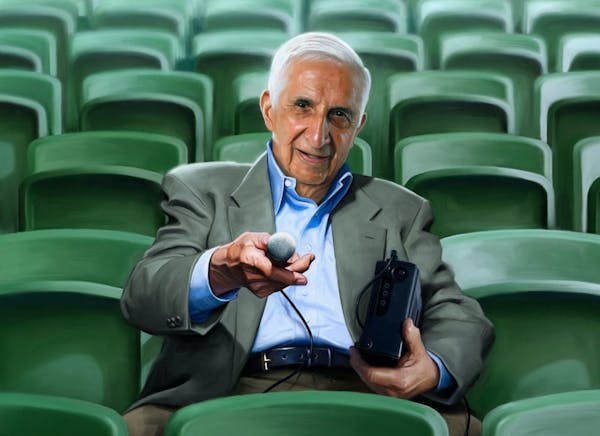The Twin Cities had gone from quaint Midwestern river towns to big cities by the end of the 1950s. The population surpassed 1 million during the decade, making it one of the 15 largest metro areas in the nation.
What the community lacked was the stamp that would legitimize its status: a Major League Baseball franchise.
Sid Hartman was part of a group led by John Cowles Jr., publisher of the Minneapolis Star and Morning Tribune, fighting for a team. Hartman began contending that the best site for the requisite new stadium would be just north of the Fairgrounds on land in Falcon Heights owned by the University of Minnesota. But Falcon Heights officials and University of Minnesota Regents opposed the plan. At that point, Minneapolis and St. Paul split forces, with each city building new stadiums — Metropolitan Stadium in Bloomington, Midway Stadium in St. Paul — in hopes of attracting a team.
It was then Hartman began referring to St. Paul as "East Germany," and his loyalty to his hometown of Minneapolis never faded. St. Paul, in his view, was the meddling little brother.
After courting Calvin Griffith's Washington Senators for years, and each time failing to persuade the owner to leave the nation's capital, Minnesota leaders were pessimistic heading to the owners' meeting at the end of the 1960 season in which two expansion teams were expected to be awarded — to Dallas and Los Angeles.
Hartman said in his autobiography "Sid!" that he took a call from the meeting informing him that Yankees co-owners Dan Topping and Del Webb were opposing any move of the Senators to Minnesota. Hartman was asked to think of any way to change the Yankees' minds.
Hartman hung up the phone and tried to think of anyone who could influence the Yankees owners. He knew that the two had undergone physicals at the Mayo Clinic, and that Dr. Bayard Horton was a Mayo department head who had worked with them.
Here's Hartman's version of what transpired: "I said, 'Doc, you can be a hero. There is supposed to be an announcement today that the Washington Senators are moving to Minnesota, but now there are complications. We need the Yankees vote to get this baseball team. You're the one guy I know who might be able to get this vote for us, if you would ask Webb and Topping to do it as a favor to you.'
"Dr. Horton became all upset. He said it took a lot of guts for me to ask him to do something that was so obviously unethical. … I was walking out of my house an hour later and the phone rang. It was Dr. Horton. He said, 'Listen, you ... I made that call. You got the vote.' "
That afternoon the AL voted to allow the Senators to move to Minnesota, while approving expansion franchises for Washington and Los Angeles.
Said Hartman: "John Cowles Sr. always felt — and I agreed with him — that an area could not be big league if it did not have a major league ballclub. We became big league on Oct. 31, 1960, when Griffith announced he was bringing his team to Minnesota.
"The excitement was unbelievable. For Minnesota to get a major league team after all the work we did — it was the greatest feeling in the world. The other sports were nothing compared to baseball at that time. Baseball was what made you big league. And the Star and Tribune had done more in getting the Twins here than any outfit in town."
Shortly thereafter, Hartman played a role in landing an NFL expansion franchise for the 1961 season. From Hartman's book: "For fifteen years, the Lakers were our only major league team. We lost them in 1960, but it still was the greatest year in the history of Minnesota sports.
"First, the long battle for baseball came to an end when Calvin Griffith announced he was bringing his ballclub to Minnesota. Second, we were awarded an NFL expansion franchise. And, third, the Gophers beat Iowa in a game between the Nos. 1 and 2 football teams in the country, they tied for the Big Ten championship, and they earned a trip to Minnesota's first Rose Bowl."
And Hartman had the inside scoop on all of it.

